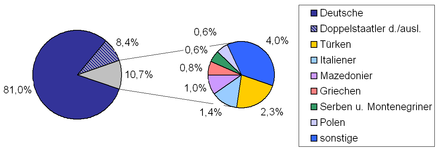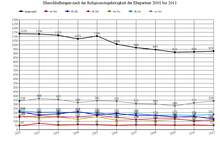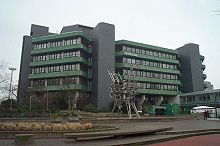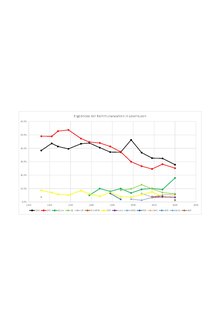Leverkusen
![]()
This article is about the city. For the court of Leverkusen see Leverkusen (Remscheid).
Leverkusen [ˈleˑvɐkuːzn̩] is an independent city and medium-sized centre in southern North Rhine-Westphalia, part of the administrative district of Cologne, geographically located in the Bergisches Land and thus part of the Rhineland. The Wupper flows into the Rhine in Leverkusen.
The city is located directly northeast of Cologne and belongs to the Rhine-Ruhr metropolitan region. With a population of over 167,000, it is one of the smaller major cities in the country. Leverkusen is best known for the Bayer Group and the Bundesliga football team Bayer 04 Leverkusen. The city of Leverkusen was founded in 1930 through the merger of the city of Wiesdorf with the communities of Schlebusch, Steinbüchel and Rheindorf.
The town owes its name to the pharmacist and chemical entrepreneur Carl Leverkus, whose family descended from the Leverkusen estate in the area of the present-day town of Remscheid. Leverkus founded a chemical factory near Wiesdorf on the Rhine around the middle of the 19th century and gave the name Leverkusen to the settlement of his workforce - this was already the name of the family seat in Lennep. In 1930 the name was transferred to the newly founded city of Leverkusen.
The present-day city of Leverkusen was created in 1975 by the merger of Leverkusen with the district town of Opladen and the town of Bergisch Neukirchen and the incorporation of the Hitdorf district of the town of Monheim. The newly divided city was then divided into three districts, with Opladen being split into districts II and III. Leverkusen has three larger city centers with pedestrian zones. They are located in the districts of Leverkusen-Mitte (Wiesdorf), Schlebusch and Opladen. Opladen is also known as the gateway to the Bergisches Land. Bergisch Neukirchen, Quettingen, Lützenkirchen, Steinbüchel and partly Schlebusch are located on the western slope of the Bergisches Land. The rest of the city lies in the Rhine plain of the Cologne Bay.
The dialect spoken in Leverkusen is mainly the northern Middle Franconian dialect of Ripuarian, also known as the "Cologne dialect". Furthermore, there are Bergisch dialects in the eastern parts of the city.
Population
Population development
In 1905 Wiesdorf had about 10,000 inhabitants, by 1914 this number had doubled to more than 20,000. After the merger of the town of Wiesdorf with the communities of Schlebusch, Steinbüchel and Rheindorf to form the city of Leverkusen on April 1, 1930, it had about 40,000 inhabitants. In 1963, the city's population exceeded 100,000, making it a major city. After the addition of the towns of Opladen (population 45,604 in 1974), Bergisch Neukirchen and Hitdorf on 1 January 1975, Leverkusen's population reached its historic high of 167,671. According to the German federal census, Leverkusen had 158,984 inhabitants on May 9, 2011. On December 31, 2017, Leverkusen had 163,577 inhabitants.
The figure shows the population development of the predecessor communities and of Leverkusen in today's urban area. The influences of industrialization from the second half of the 19th century, especially the settlement of the Bayer company in 1891, the influence of the two world wars, the again stronger rate of increase after the Second World War, the influence of the "Pillenknick" around 1970 and finally the economic recession in the 1980s are clearly visible.
The population breaks down by age as follows (as of September 30, 2016):
| Age group | Total |
| 0 to under 3 | 4.627 |
| 3 to under 6 | 4.513 |
| 6 to under 10 | 6.067 |
| 10 to under 16 | 9.355 |
| 16 to under 18 | 3.358 |
| 18 to under 21 | 5.185 |
| 21 to under 25 | 7.211 |
| 25 to under 45 | 40.702 |
| 45 to under 65 | 49.541 |
| 65 and older | 35.603 |
| total | 166.162 |
Demographics
As of October 2019, 167,433 people resided in Leverkusen, of which 85,448 were female and 81,985 were male. 27,565 residents were non-Germans; this corresponds to a proportion of foreigners of approx. 16.5 %.
57,623 inhabitants (approx. 35.2 %) had a migration background in 2018. Among the total of 4,989 children in daycare facilities, 2,061 (41.3 %) have a migration background.
Among the 166,537 residents (as of June 2020), 28,428 are minors (17.1%) and 35,786 are over 65 (21.5%).
In 2017, 82,300 people were employed in Leverkusen as a place of work. Of these, around 72.8 % were in the service sector, 27.1 % in manufacturing and 0.1 % in agriculture, forestry and fishing.
In 2016, 79,546 inhabitants of Leverkusen were employed, of which approx. 49.6 % commute. With 59,844 persons, 75.2 % of the employed population was subject to social insurance contributions.
Marriages
Compared to 2001, the number of marriages per year decreased by about 18% to 929 in 2011; in 2001, there were 1133. In contrast, the number of marriages among partners who both belong to the Protestant Church increased by 6.1% from 49 to 52, and among those who both belong to another religious community or no religious community increased by 0.3% from 338 to 339.
In the case of spouses who are both members of the Catholic Church, the number of marriages fell by 39.5% from 210 to 127; in the case of spouses where one is Roman Catholic and the other Protestant, the number fell by 18.8% from 149 to 121; in the case of spouses where one is a member of the Protestant Church and the other is a member of some other religious community or none at all, the number fell by 33.9% from 165 to 109, and for spouses where one belongs to the Roman Catholic Church and the other to another or no religious denomination, the number of marriages fell by 18.5% from 222 to 181.

Population development

Distribution of nationalities in Leverkusen in December 2006

Marriages according to the denomination of the spouses
Politics
city council
See also: Results of the local elections in Leverkusen
Election of the Leverkusen City Council 2020
(in %)
%
30
20
10
0
27,8
25,2
17,9
6,1
6,0
5,7
4,9
3,5
2,9
CDU
SPD
Green
BL
OP
AfD
FDP
Left
Otherwise.
gains and losses
compared to 2014
%p
10
8
6
4
2
0
-2
-4
-6
-8
−4,7
−3,0
+8,6
−1,0
+0,7
+5,7
+1,1
−0,3
−7,0
CDU
SPD
Green
BL
OP
AfD
FDP
Left
Otherwise.
Template:Ballot Chart/Maintenance/TITLE too long
The Leverkusen City Council has 52 seats (plus a vote for the Lord Mayor), which are distributed among the individual parliamentary groups or parties as follows (as of September 13, 2020):
| CDU | SPD | GREEN | MAYOR'S LIST | OP | FDP | AfD | The Left | Departure Leverkusen | Büfo - Climate list | Total |
| 14 | 13 | 9 | 3 | 3 | 3 | 3 | 2 | 1 | 1 | 52 |
The CDU has the most seats in the city council with 14 seats, followed by the SPD with 13 seats.
Lord Mayor
In North Rhine-Westphalia, the dual leadership of the city administration consisting of Lord Mayor and Lord Mayor was abandoned in 1994 and combined in the office of the full-time Lord Mayor. He is the chairman of the council, head of the city administration and representative of the city. He is directly elected by the electorate and his term of office is five years.
(Lord) Mayor since 1930
| Period | Name | Party |
| 1930–1933 | Heinrich Claes | Center |
| 1933–1938 | Wilhelm Toedtman | NSDAP |
| 1938–1945 | Ludwig Simon | |
| 1945 | August Adolphi | SPD |
| 1945–1946 | Heinrich Claes | CDU |
| 1946–1949 | John Dott | CDU |
| 1949–1951 | John Knight | SPD |
| 1951–1954 | John Dott | CDU |
| 1954–1961 | Wilhelm Dopatka | SPD |
| 1961–1964 | Heinrich Lützenkirchen | CDU |
| 1964–1979 | Wilhelm Dopatka | SPD |
| 1979 | Heinrich Lützenkirchen | CDU |
| 1979–1984 | Wolfgang Obladen | CDU |
| 1984–1994 | Horst Henning | SPD |
| 1994–1999 | Walter Mende | SPD |
| 1999–2004 | Paul Hebbel | CDU |
| 2004–2009 | Ernst Küchler | SPD |
| 2009–2015 | Reinhard Buchhorn | CDU |
| since 2015 | Uwe Richrath | SPD |
(Chief) City Directors 1946 to 1994
| Period | Name | Party | Title |
| 1946–1951 | Heinrich Claes | CDU | City Manager (previously Mayor) |
| 1951–1963 | Otto Grimm | City director, from 1955 chief city director | |
| 1963–1975 | Walter Bauer | CDU | Chief City Manager |
| 1975–1989 | Bruno Krupp | SPD | Chief City Manager |
| 1989–1994 | Walter Mende | SPD | Chief City Manager |
Finance
For several years now, Leverkusen's budget has not been balanced. Expenditure regularly exceeds income, which means that the city is in an emergency budget situation. New investment measures may only be carried out with the approval of the district government. Larger investment projects that are not matched by expected revenues are regularly criticized by the district president. In 2015, the municipal per capita debt was approximately €1,684. Since 2009, Leverkusen has been a member of the action alliance Raus aus den Schulden (Get Out of Debt), in which over-indebted cities, especially in the Ruhr region, fight for their ability to act. Currently, the debt level of the city of Leverkusen is about € 276 million.
Coat of arms
The coat of arms of the city of Leverkusen shows in silver the blue-crowned, tongue-tied and armed onion-tailed red Bergisch lion, covered with a black alternate crenellated bar. The coat of arms was awarded to the city on August 19, 1976 by the district president in Cologne.
The lion is the heraldic animal of the counts or dukes of Berg, who once ruled over what is now the city of Leverkusen. It was adopted from the earlier coats of arms of Leverkusen, Hitdorf and Bergisch Neukirchen. The change battlement bar was taken from the coat of arms of the town of Opladen in 1883 and is traced back to the brothers Gerhard and Giso von Opladen, who lived in the 13th century.
Previously, the city had a different coat of arms, which was awarded to the city of Wiesdorf by the Prussian State Ministry in 1923 and adopted by the newly founded city of Leverkusen in 1930. This coat of arms also showed the lion and, in the lower part of the shield, a silver wave with a golden punt with a silver superstructure at the stern and rudder. The barge symbolized the Wiesdorf ferry across the Rhine to Merkenich, which had a long tradition and ceased operation in 1969.
Instead of the coat of arms, the city and many municipal institutions have often used a logo consisting of a green square on top with a white vertical bar on publications, signs, etc. since the 1970s.
The city also flies a flag and banner bearing the emblems of the coat of arms on white cloth.
Twinning
Leverkusen maintains a total of eight town twinning arrangements, almost all of which were established on the basis of voluntary contacts between citizens and only later expanded to become official town twinning arrangements. They are therefore based primarily on the interests and friendly exchanges of families or associations.
 The first town twinning was concluded with Oulu in Finland in 1968. At the beginning of this partnership it was mainly about an exchange of both cities in the fields of culture, youth, school and sports. At the beginning of the 90s, efforts began to develop the economic sector as well. In 1995, the mayors of both cities signed an "Agreement between the twin cities of Oulu and Leverkusen in the field of economic cooperation". The German-Finnish Society of Leverkusen, founded at the same time in 1968, supports the partnership relations.
The first town twinning was concluded with Oulu in Finland in 1968. At the beginning of this partnership it was mainly about an exchange of both cities in the fields of culture, youth, school and sports. At the beginning of the 90s, efforts began to develop the economic sector as well. In 1995, the mayors of both cities signed an "Agreement between the twin cities of Oulu and Leverkusen in the field of economic cooperation". The German-Finnish Society of Leverkusen, founded at the same time in 1968, supports the partnership relations.- A partnership with Bracknell Forest in Great Britain was established from Opladen in 1973 and maintained through friendly contacts and Opladen clubs. When Opladen became part of the city of Leverkusen in 1975, Leverkusen took over the partnership, the main aim of which is to strengthen European unity.
.svg.png) The relationship with Ljubljana/Laibach in Slovenia began in 1979.
The relationship with Ljubljana/Laibach in Slovenia began in 1979.- Relations with Nof HaGalil in Israel began in 1980, with a circle of friends supporting the Israeli partnership.
- Chinandega in Nicaragua is another twin town whose partnership primarily aims to organize cooperation between developing and industrialized countries. Many development and reconstruction projects have been carried out by Leverkusen, for example a sewage plant was installed in Chinandega. As a result, 6,000 people are once again supplied with clean drinking water.
 At the time of the GDR, a German-German town twinning was established with Schwedt in Brandenburg, which was intended to express the cohesion despite the two German states.
At the time of the GDR, a German-German town twinning was established with Schwedt in Brandenburg, which was intended to express the cohesion despite the two German states..svg.png) The relationship with Villeneuve d'Ascq in France is based on contacts between individual families that existed before the official twinning. In 2001, the mayors of both towns got talking and decided on an official town twinning. School exchanges take place on a regular basis.
The relationship with Villeneuve d'Ascq in France is based on contacts between individual families that existed before the official twinning. In 2001, the mayors of both towns got talking and decided on an official town twinning. School exchanges take place on a regular basis. As early as 1951, an honorary sponsorship was granted to the former German city of Ratibor/Racibórz in Poland. In 2002, it was officially supplemented by a German-Polish town twinning.
As early as 1951, an honorary sponsorship was granted to the former German city of Ratibor/Racibórz in Poland. In 2002, it was officially supplemented by a German-Polish town twinning.- In 2014, the partnership with Wuxi was concluded. A business partnership with the Chinese city of Wuxi had already existed since 2006, which is intended to facilitate an exchange at the business level. In addition, there is an association on the Leverkusen side that also aims to promote private contacts between the two cities.

Logo Leverkusen

Coat of arms Opladen

City arms of Wiesdorf and Leverkusen 1923-1975

Leverkusen's debt from 1996 to 2011

The Leverkusen town hall (1977 to 2007), in front of it the Aquamobil

Results of the local elections in Leverkusen

City Hall and City Hall Gallery (2010)
Search within the encyclopedia